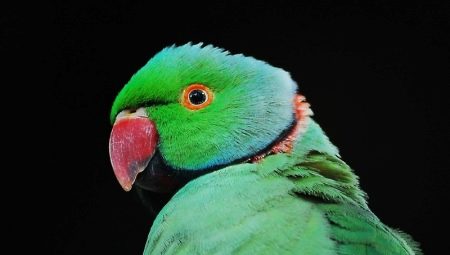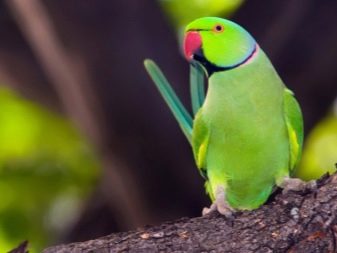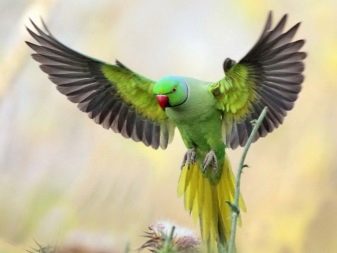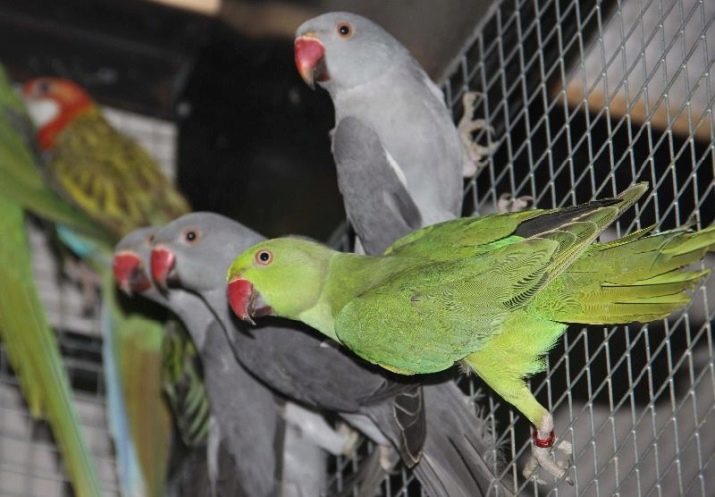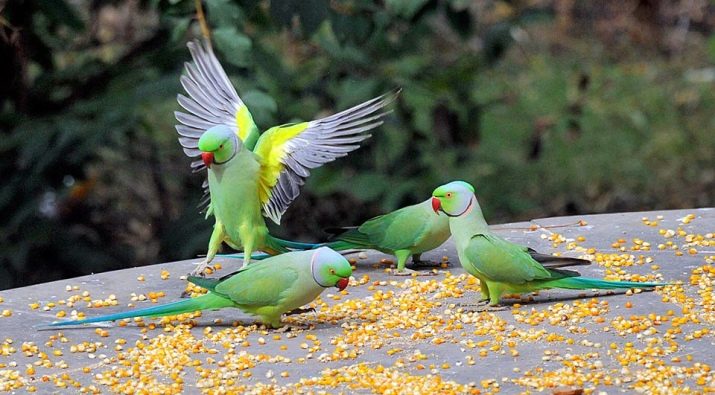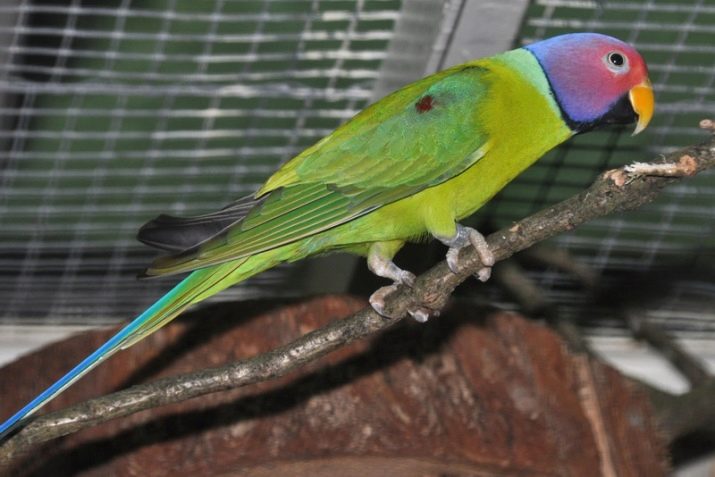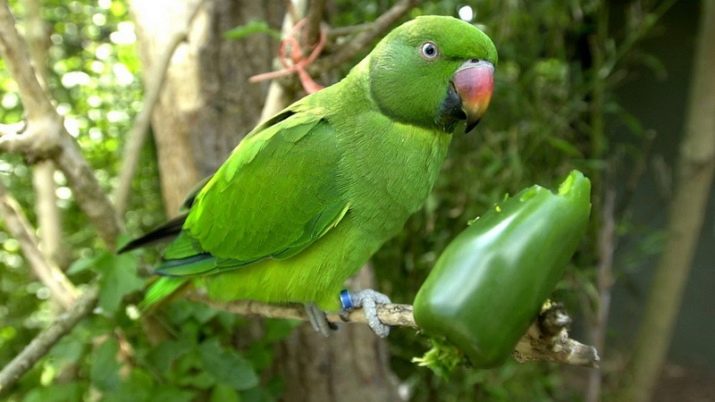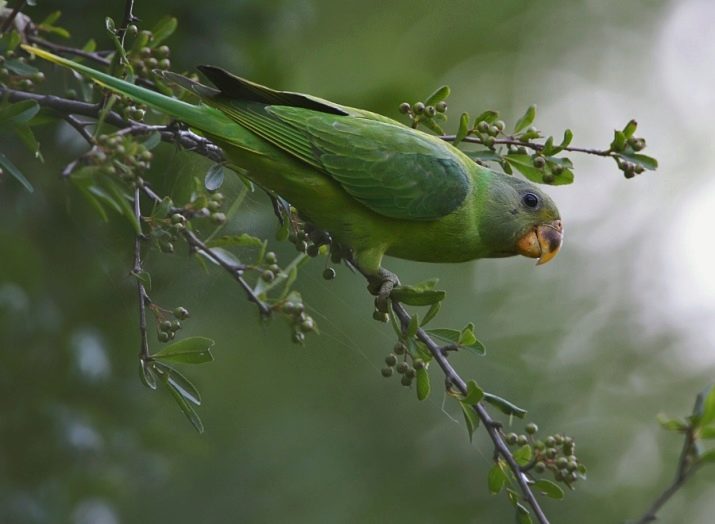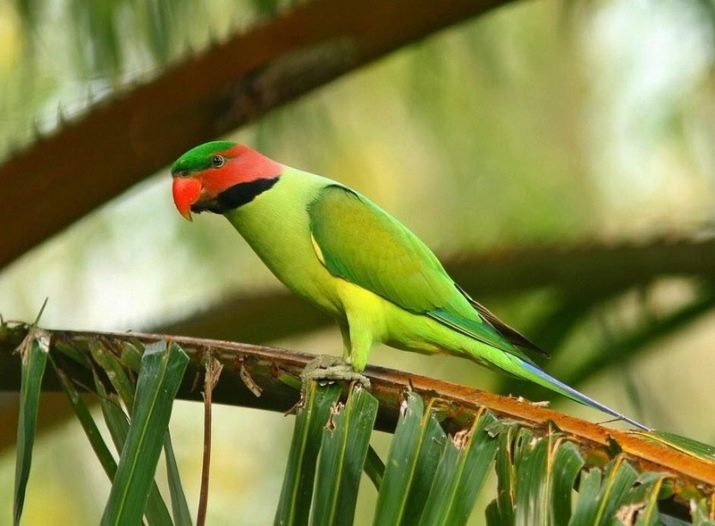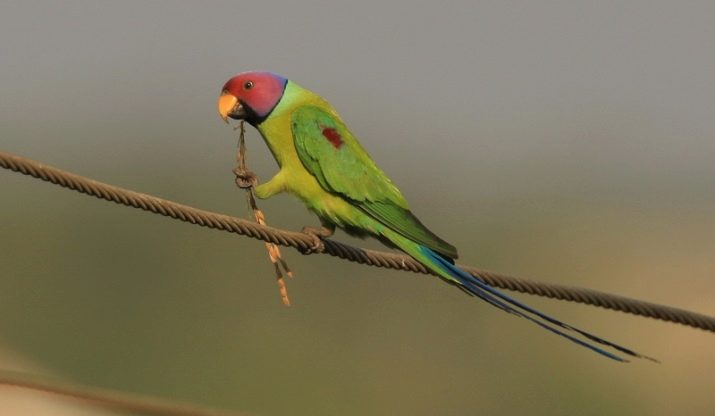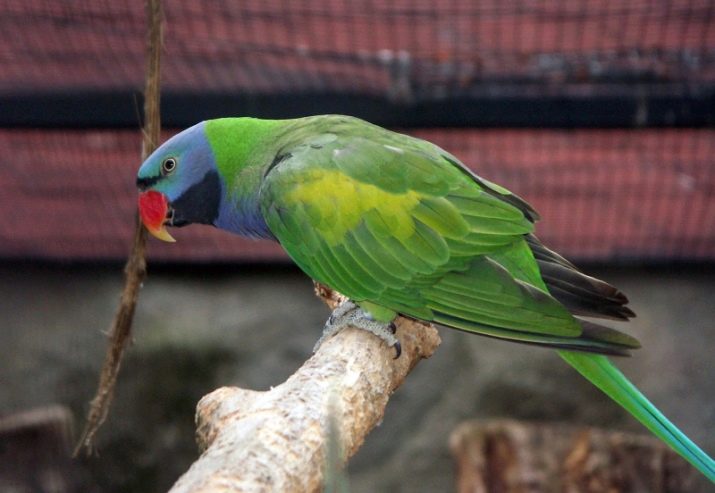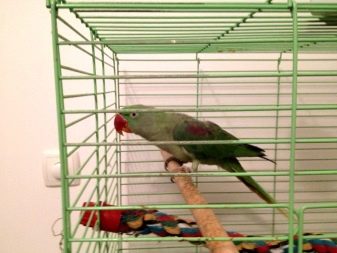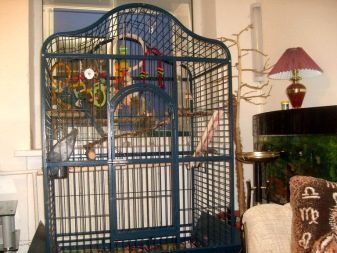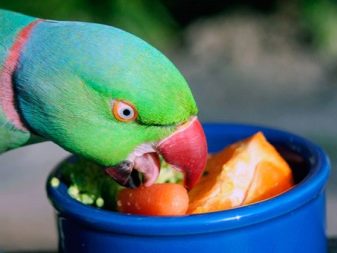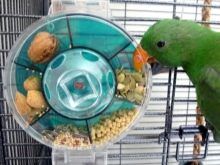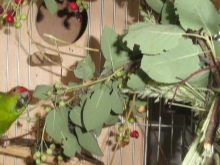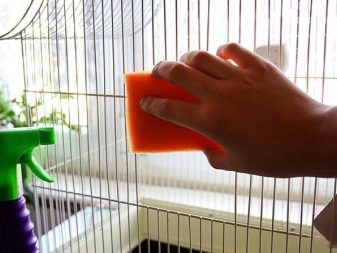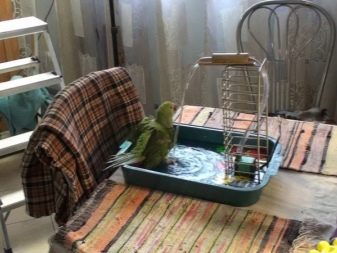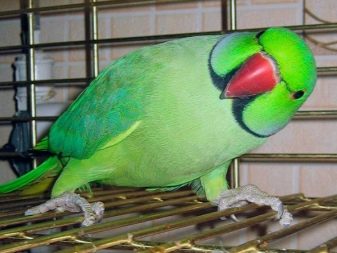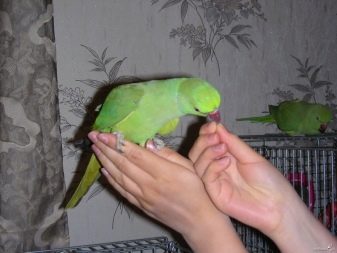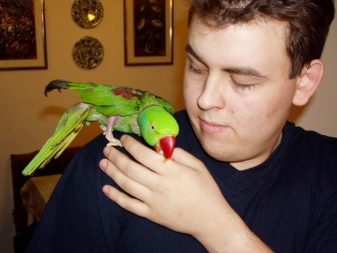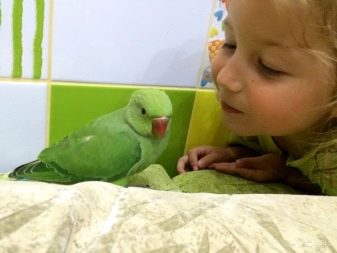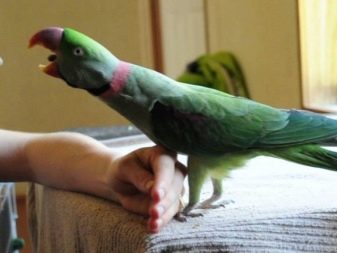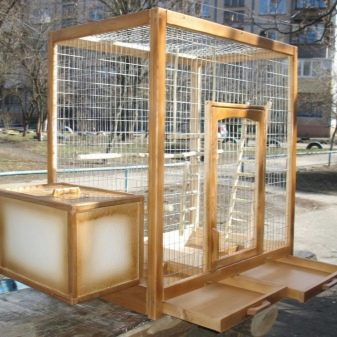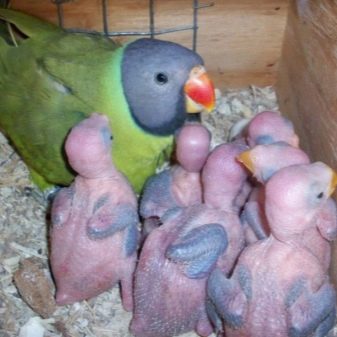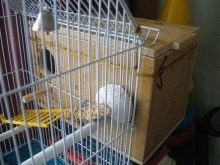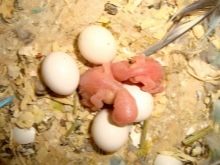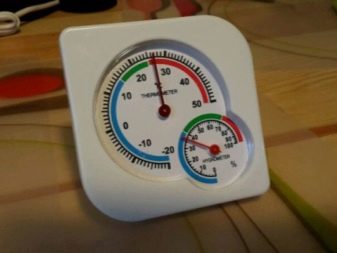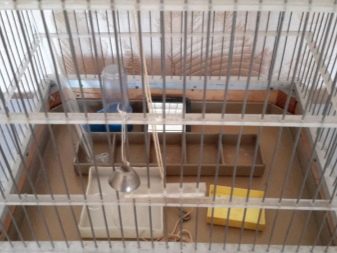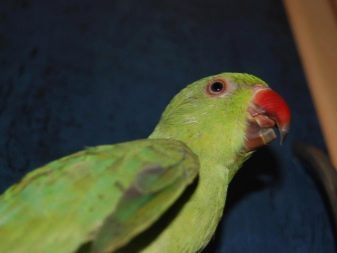Necklace parrots are very intelligent and have a friendly disposition. Therefore, these birds cause great sympathy from a wide audience, and every year there are more and more willing to have such a pet at home. In some sources, necklace parrots are called ringed. Initially, this breed lived on the African and Asian continents. Later, the necklace parrots were introduced to Australia and India, where they formed new species.
Description
Depending on the species, the body length of an adult individual may be in the range of 30-50 cm, the wingspan is 15-16 cm, the total weight is about 150 g. developed, but the beak is quite large, so when walking the parrot uses it as an additional support.
The main color of the parrot is usually emerald green, and around the neck there is a decoration in the form of a dark stripe. It looks like a necklace, and the name of the breed comes from it - necklace. By this necklace you can determine the gender of the bird. It is found only in the male, and in the girl such decoration is traditionally absent: as in most breeds of birds, the male parrots have a brighter color in order to attract the attention of the female. The wings are spotty on top, yellow-green, and bottom are gray, there is an orange halo around the eyes, the beak is bright red.
To determine the age of an adult individual can be on several grounds. The older the bird, the more intense its beak and feather color. A young parrot has a pale pink beak, and a characteristic color border appears at about 6-7 months of age.
At the age of one year, the bird begins to molt, and it is during this period that the most recognizable necklace begins to appear. At first the decoration is barely noticeable, and finally it will be formed by the age of three birds. In addition, the two main tail feathers in chicks grow by half a year, at an earlier age they are absent.
At a young age, it is very difficult to determine the sex of a bird, since chicks of both sexes have the same pale plumage color. Therefore, buying a young parrot is better in special stores where an experienced seller will be able to correctly determine the sex.
In nature, the parrot necklace lives in a tropical climate, they prefer to settle in huge flocks of up to several hundred individuals, displacing other species of birds. In search of food, they fly out of their nests in the early morning and evening, when there is no sweltering heat, from which they hide during the day in the shadow of thick branches. They feed on plant food: fruits, grass, leaves and seeds of plants.
The female lays eggs 2 times per season (some species - 3 times), usually from 2 to 4 pieces. Chicks appear in about a month, and after another one and a half or two months they are ready for independent living.
Kinds
The genus of ringed parrots currently has 13 species.
- Pink Chest (Psittacula alexandri). The size of an adult individual is 30-35 cm, tail length is 22 cm. The main color of the plumage is green, the head is blue, there are black stripes on the forehead, the breast and part of the abdomen are painted pink. It lives mainly in some provinces of India, where it lays in huge flocks and ruins rice and other agricultural plantations, for which it is subject to mass destruction by people.
Since mainly females are imported to the European part, they are practically not subject to reproduction in captivity.There are 8 subspecies of this species, depending on some of the details of coloring plumage and body size.
- Emerald (Psittacula calthropae). Lives in Sri Lanka. It has a body size of 30 cm, tail length is 13 cm. The main color is blue-green, the head and upper part of the body are blue with a grayish tinge, and there is a bright green necklace around the neck. The main tail feathers are also blue, and the tip of the tail is yellow. At the male the beak is red-brown, at the female - black.
- Gray-headed (Psittacula caniceps). In some sources it is indicated as a creamery. The sizes are large - in length can grow up to 50-55 cm. The head, as the name suggests, is gray, with a bluish tinge, there is yellow down on the cheeks and ears. Places there are wide black stripes, bright orange border around the eyes. It lives on the coast of the Indian Ocean. Little studied view.
- Malabar (Psittacula columboides). It inhabits parts of India. Body length is standard for the necklace species - 35-36 cm, tail feathers length - 20-25 cm, upper body gray, lower green with a bluish hint. The male has a yellow-green fluff around the eyes, on the abdomen and lower part of the tail. In the female, blue hues prevail in the coloration.
- Redhead (Psittacula cyanocephala). Red-headed ringed parrots can be found in India, China, Nepal, some areas of Pakistan, and also in Sri Lanka. Prefer a tropical climate. This type of ringed is considered one of the most beautiful. The main plumage of a rich emerald green color casts a little olive. The head and neck are dark cherry, with a slight bluish tinge. On the wings and on the neck are black markings, the beak of males is light yellow, and of females red.
They rarely breed in captivity, since individuals of both sexes are similar to each other, which makes it difficult to select partners for a couple. Favorably differs from the relatives in a pleasant melodious voice, easily gives in to training.
- Mauritius (Psittacula echo). The length of an adult individual is 42 cm; it lives in Madagascar, Mauritius and some other islands of the Indian Ocean. Rare, endangered species. Today, the population is about one hundred individuals, mostly male.
- Alexandrov (Psittacula eupatria). Another large representative of the necklace family can grow up to 60 cm. It lives in some areas of South and Southeast Asia, on the Andaman Islands and Sri Lanka. The color is traditionally green, the male has a pink necklace with a black necklace.
The view is well-learning, it can memorize up to 15 words. In cages and aviaries lives long. Depending on the details, it is divided into 5 subspecies.
- Parrot Finsha (Psittacula finschii). The length of the bird is 35-40 cm, color is green with red foci, the head is gray. It lives in Thailand, China, Vietnam and other areas of Asia. Its peculiarity is that it can live at an altitude of up to several thousand meters above sea level.
- Himalayan (Psittacula himalayana). It lives in India and Vietnam. Color and dimensions are identical to the previous form. The female has a paler coloring, and, unlike the males, she has no red stripes on the wings. It is divided into two subspecies inhabiting different areas.
- Indian ringed (Psittacula krameri). Lives in some areas of Africa and South Asia. It is considered the largest population among the parrots. Prefers to settle in close proximity to the person. The main color of the bird is green, the color of foliage, with a blue tint, there are several black feathers on the wings, a head with a bluish tinge; The female is green.
When flapping wings, it is clear that their lower feathers are dark gray. On the tip of the tail, yellowish feathers.
- Nixtail ringed (Psittacula longicauda). Homeland is considered Indonesia, Malaysia, Singapore. Body size is 40 cm, tail length is 25 cm. Body color is green, beak is red-brown in male, black in female.On the head are red stripes. There are five different subspecies of the stringed parrot living in different areas.
- Pink-headed Ringed (Psittacula roseata). Habitat - India. Prefers forest areas, settles in small groups. Body length - 35 cm, color green, head gray-blue, red-brown shapeless spots on wings. Males have a melodic timbre, calm character, well trained, but human speech is practically not trainable.
- Chinese ringed (Psittacula derbiana). The bird is large, with a body up to 50 cm and a tail about 30 cm long. It lives in the southern provinces of China and India. Body color on top of the green, below - lilac-blue. Between the eyes and on the neck, the black stripes, the breast and the main feathers on the wings are colored gray-blue. Well teach human speech.
Content policy
Necklace parrots are unpretentious in everyday life and do not require any special conditions for complete care. The main condition for their proper maintenance is the presence of a large cage, and better - an aviary. Since the bird does not possess strong paws, it prefers to move in flight. And for this she needs space.
The minimum allowable size of the cage for the kozherovo parrot is 70 cm in height and 50 cm in length. And if joint maintenance of a male together with a female is supposed, it is better to choose a room of at least 2-3 square meters for a couple. m. And even if the aviary is spacious enough, it is necessary to release the parrot daily from it so that it can spread its wings and train its muscles in flight.
In the cage there must be several bars and many toys. These can be ladders, bells, a mirror and other interesting items. With a sufficient number of different attributes, parrots tolerate loneliness.
An important detail: the cage should be made of durable metal with anti-corrosion treatment. Since the parrot has a powerful beak, it can easily kill the cage bars if they are not strong enough.
The lifespan of a parrot often depends on its conditions of detention. According to statistics, in captivity parrots live much longer than in the natural environment. If you ensure optimal living conditions and constant attention and care from the owner, then the average lifetime of a parrot will be 50 years.
There are also isolated cases when the parrots of this breed lived to 70 years. But in nature, parrots rarely step over the age limit of 10-15 years. This is due to the fact that in artificial conditions, snakes and other enemies in nature do not attack birds. In addition, in captivity in parrots food is well balanced and there is no need to get food on their own.
Ensuring proper feeding of the necklace parrot is a simple matter.
- The main component of the nutrition of parrots in captivity is a grain mixture consisting of 35-40% of millet and various additives in equal parts: sunflower seeds, feed for canaries, oats or oatmeal, wheat grains.
- To diversify the parrot's diet, you can add fresh vegetables, boiled eggs, low-fat cottage cheese and sometimes feed it with unsalted hard cheese.
- Occasionally, the parrot can be given peeled walnut kernels, but in limited doses, since they contain a lot of fatty amino acids.
- Parrots love to nibble on various objects, so from time to time you can throw small wooden twigs and leaflets of house plants into their cages. The main thing is to ensure that they are not poisonous.
To keep your pet from getting sick, you must abide by basic hygiene measures. In addition to daily cleaning of the cage, the parrot must be periodically bathed. To accustom birds to water procedures should be gradually, so as not to scare away. To begin with, try sprinkling lightly on it through the rods from the spray bottle.
When the parrot gets used to this custom, you can put a container with water in the aviary so that it can splash on its own. If there is no rejection, put the cage with the parrot in the bath and water it on top of the shower. Some owners teach the bird to swim right in the bathroom without a cage.
Ozherelovy parrot is able to withstand sudden changes in temperature, However, the most comfortable conditions of maintenance are 20–25 degrees of heat and humidity not less than 60%. Parrots are awake for exactly half a day. Therefore, in winter, they need to artificially extend daylight with additional lighting, and in summer, on the contrary, cover the cage with a dark cape in order to provide them with proper rest.
The same way they can be reassured if the bird begins to bother with its unpleasant cry. This feature is present in most members of this genus. For example, the Indian ringed parrot often makes harsh and very unpleasant sounds for human perception.
The patient owner is able, over time, to wean the bird from this bad habit.
Intelligence
Ozherelovy parrots appreciate for their good-natured temper, the ability to quickly tame and the ability to learn to talk. Parrots of this breed feel great in close proximity to people. Much is said about their intelligence and learning. If you take a young chick up to a year, then you can teach him to sit on the arm or on the shoulder to the owner, take from his hands the food and some other techniques. But the main thing for which many choose this particular breed of parrots is to teach them to talk.
To train the parrot of human speech, It is necessary to systematize the learning process. Since it will take more than one day, you need to have endurance and patience. Numerous observations show that best of all parrots perceive the female and childish timbre of the voice, since they have a thinner register. Males learn faster than females, but it has been observed that diction is much better for females.
The bird can achieve the greatest results if it contains one. Living in a pair of individuals learn much worse. To get speech success you need to repeat short phrases for the parrot or 1-2 words every day. Necklace parrots can remember up to fifty words.
If you are planning to train a parrot, it is better to choose chicks at a young age. The older the bird, the less it can be trained. Before the year, the bird can be taught not only not to be afraid of hands, but also to memorize whole sentences. But after three years, the bird becomes almost untrained.
Breeding characteristics
Necklace parrots breed very well at home. It is possible to wait for progeny from a couple at the age of three years - it is by this age that the physiological development of birds is fully completed. In addition, younger individuals hatch eggs poorly, and when chicks appear, they are poorly cared for. If the bird is old, this is also not very good - from it will be weak offspring.
To obtain offspring, you need to create a pair of comfortable conditions. For their maintenance, it is better to purchase a house not less than 50 cm wide, 150 cm high and a hole for owners with a diameter of 7-10 cm. You need to lay something soft at the bottom - sawdust or peat, creating the illusion of a real nest.
The nesting house should be equipped with a crossbar to make it convenient for birds to enter their dwelling. It should be installed a few centimeters below the inlet of the house. If the floor area in the house is too small, the chicks will be cramped and they can cripple each other. For as long as the mating season lasts for the birds, they need to be given special vitamins, add more vegetables and fruits to the diet, and also germinated grain.
Nestlings hatch not at the same time, and in one nest progeny of different ages will be obtained. Sometimes it happens that not all the eggs hatch chicks. Some of them die at the embryo stage.This can happen if the nest is not clean enough or too small.
To control the climatic conditions inside the room where new offspring are raised, it is necessary to equip with a thermometer and a hygrometer to measure humidity. To improve air quality, it is advisable to install an ionizer in the room. Besides, need to regularly ventilate the room.
Diseases and their prevention
Virtually all the diseases that appear in the necklace parrots arise from improper care. Consider the most common diseases.
- Smallpox - manifested in the absence of appetite, decreased activity. May be accompanied by vomiting, the appearance of white plaque on the tongue and (or) an abscess on the head.
- Psittacosis transmitted through litter and manifested by muscle cramps and mucous secretions. Sometimes a disease can cause paralysis. At home is less common than in nature.
- The presence of parasitic worms or worms, that can be transmitted from other individuals. The disease is not amenable to treatment, it manifests itself in refusal to eat, inhibited reaction.
- Tracheal mite. Signs - sore throat, sneezing, vomiting.
- Escherichiosis - infection of the intestine and change its microflora. The disease can occur as a result of stress or due to malnutrition. Manifested in the absence of appetite and apathy.
- Newborn chicks are often diagnosed with foot reversal. This is a sign of a disturbance in the nervous system, the cause of which may be a lack of vitamin B. Such chicks are not viable.
To reduce the risk of infections and viruses, it is necessary to clean the cage daily: thoroughly clean all the items in it, wash the dishes for food and drink, change food and water daily. At the first sign of a suspicious bird behavior, you should immediately contact a veterinarian. Before you let the parrot out of the cage, you need to check whether the vents and doors are closed so that the bird does not fly out into the street.
It is desirable to hang the windows so that the parrot does not hit the glass.
In some cases, a sick bird can be recognized already at the stage of purchase. In a healthy individual, the plumage should be shiny and smooth to the touch, and also fit snugly to the body. If the feathers are dirty, bristling in different directions, breaking, then, most likely, the bird is not very healthy.
Owner reviews
Despite the great diversity of the necklace parrots, everyone has a few common signs. So, among the advantages of these birds, most of the owners call the beauty and remarkable mind. The ringed parrot can be taught not only to speak, but also to carry out various commands, which is why everyone, especially children, is enraptured. Some types of necklace pamper their owners with beautiful singing.
However, if the parrot is not in the best mood, its sharp piercing cry can cause a storm of negativity not only among the household, but also among the neighbors. In addition, the maintenance of this bird is not cheap: buying an open-air cage, toys, medicines, vaccinations, trips to the veterinarian, as well as special food can cost a lump sum. Also, some owners point out that birds make a lot of noise and spoil the furniture.
If all these difficulties do not stop you, it is worth starting your acquaintance with this breed by purchasing an emerald ringed parrot. Most reviews of this type are positive. It has been observed that it is this species that is most trained in human speech and quickly gets used to hands, becoming a full-fledged member of the family.
For more information on how to feed the necklace parrot, see the next video.
